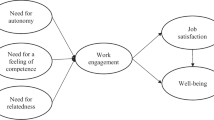Abstract
This study developed a multidimensional scale of benefits satisfaction and utilized a discrepancy model to examine the determinants of employee benefits satisfaction. The empirical findings are based on the survey responses of 205 employees in a hospital. The results indicate that pay level, female gender and exempt status employees are positively related to benefits satisfaction. Further, age and education level are negatively related to benefits satisfaction.
Access this article
We’re sorry, something doesn't seem to be working properly.
Please try refreshing the page. If that doesn't work, please contact support so we can address the problem.
Similar content being viewed by others
References
Allen, R.E., and Keaveny, T.J. 1983. Costing out a wage and benefit package.Compensation Review, 15(2): 27–36.
Allen, R.E., and Keaveny, T.J. 1988.Contemporary Labor Relations (2nd ed.). Reading, MA: Addison-Wesley.
Becker, G. 1975.Human Capital (2nd ed.). Chicago: University of Chicago Press.
Bergmann, T.J., and Bergmann, M.A. 1987. How important are fringe benefits to employees?Personnel, 64 (12): 59–64.
Brousseau, K.R. 1983. Toward a dynamic model of job-person relationships: Findings, research questions, and implications for work system design.Academy of Management Review, 8:33–45.
Dreher, G.F. 1981. Predicting the salary satisfaction of exempt employees.Personnel Psychology, 34:579–589.
Dreher, G.F., Ash, R.A., and Bretz, R.D. 1988. Benefit coverage and employee cost: Critical factors in explaining compensation satisfaction.Personnel Psychology, 41:237–254.
Duncan, G.J. 1976. Earnings, functions and nonpecuniary benefits.Journal of Human Resources, 11:462–483.
Dyer, L., and Theriault, R. 1976. The determinants of pay satisfaction.Journal of Applied Psychology, 61:596–604.
Ehrenberg, R.G., and Smith, R.S. 1988.Modern labor economics (3rd ed.). Glenview, IL: Scott, Foresman and Company.
England, P. 1984. Socioeconomic explanations of job segregation. In H. Remick (Ed.), Comparable worth and wage discrimination: 28–46. Philadelphia: Temple University Press.
Erikson, E.H. 1963.Childhood and Society (2nd ed.). New York: Norton.
Freeman, R.B. 1981. The effects of unionism on fringe benefits.Industrial and Labor Relations Review, 34:489–509.
Freeman, R.B., and Medoff, J.L. 1979. The two faces of unionism.The Public Interest, 57:69–93.
Greenberg, J., and McCarty, C.L. 1990. Comparable worth: A matter of justice. In G.R. Ferris and K.M. Rowland (Eds.)Research in personnel and human resources management, vol. 8: 265–302. Greenwich, CT: JAI Press.
Hall, D.T. 1976.Careers in organizations. Pacific Palisades, CA: Goodyear.
Hall, D.T., and Morgan, M.A. 1983. Career development and planning. In K. Pearlman, F.L. Schmidt, and W.C. Hamner (Eds.),Contemporary Problems in Personnel: 217–237. New York: Wiley.
Heneman, H.G., III 1985. Pay satisfaction. In K.M. Rowland and G.R. Ferris (Eds.),Research in Personnel and Human Resources Management, vol. 3: 115–139. Greenwich, CT: JAI Press.
Heneman, H.G., III, and Schwab, D.P. 1985. Pay satisfaction: Its multidimensional nature and measurement.International Journal of Psychology, 20:129–141.
Hirschman, A.O. 1970.Exit, Voice and Loyalty. Cambridge, MA: Harvard University Press.
Hulme, R.D. and Bevan, R.V. 1975. The blue-collar worker goes on salary.Harvard Business Review, 53(2):104–112.
Lawler, E.E., III, 1971.Pay and Organizational Effectiveness: A Psychological View. New York: McGraw-Hill.
Lawler, E.E., III, 1981.Pay and Organization Development. Reading, MA: Addison-Wesley.
London, M., and Stumpf, S.A. 1982.Managing Careers. Reading, MA: Addison-Wesley.
Lust, J.A. 1987.Correlates of Employee Benefit Satisfaction. Paper presented at the annual meeting of the Southern Management Association, New Orleans, Louisiana.
McCaffery, R.M. 1988.Employee Benefit Programs: A total Compensation Perspective. Boston: PWS-Kent.
Madigan, R. 1985. Comparable worth judgments.Journal of Applied Psychology, 70: 137–147.
Mahoney, T.A. 1983. Approaches to the definition of comparable worth.Academy of Management Review. 8:14–22.
Mahoney, T.A. and Blake, R.H. 1979.Occupational Pay as a Function of Sex Stereotypes and Job Content. Paper presented at the annual meeting of the Academy of Management, Atlanta.
Milkovich, G.T. and Newman, J.M. 1990.Compensation (3rd ed.). Homewood, IL: BPI.
Mincer, J. 1974.School, Experience and Earnings. New York: National Bureau of Economic Research.
Mincer, J. and Polachek, S. 1978. Women's earnings re-examined.Journal of Human Resources, 13:119–135.
Motowidlo, S. J. 1982. Relationship between self-rated performance and pay satisfaction among sales representatives.Journal of Applied Psychology, 67:209–213.
Mullahy, C.M. 1989. Cutting healthcare costs with case management.Personnel, 66(9): 50–51.
Nunnally, J.C. 1978.Psychometric Theory. New York: McGraw-Hill.
Oaxaca, R. 1973. Male-female wage differentials in urban labor markets.International Economic Review, 14:693–709.
Pfeffer, J. and Ross, J. 1980. Union-non-union effects on wage and status attainment.Industrial Relations, 19:140–151.
Pfeffer, J. and Ross, J. 1981. Unionization and female wage and status attainment.Industrial Relations, 20:179–185.
Psacharopoulos, G. 1985. Returns to education: A further international update and implications.Journal of Human Resources, 20:583–604.
Rees, A. 1977.The Economics of Trade Unions (2nd ed.). Chicago: The University of Chicago Press.
Reuter, C.D. 1990. The real cost of managing managed healthcare.Compensation and Benefits Review, 22(3): 14–17.
Scarpello, V., Vandenberg, R.J. and Huber, V. 1988. Compensation satisfaction: Its measurement and dimensionality.Journal of Applied Psychology, 73:163–171.
Schein, E. 1978.Career Dynamics: Matching Individual and Organizational Needs. Reading, MA: Addison-Wesley.
Schwab, D.P. and Wallace, M.J. 1974. Correlates of employee satisfaction with pay.Industrial Relations, 13:78–89.
Shepela, S.T. and Viviano, A.T. 1984. Some psychological factors affecting job segregation and wages. In H. Remick (Ed.),Comparable Worth and Wage Discrimination: 47–58. Philadelphia: Temple University Press.
Stumpf, S.A. and Colarelli, S.M. 1980. Career exploration: Development of dimensions and some preliminary findings.Psychological Reports, 47:979–988.
Super, D.E. and Bohn, M.J. 1970.Occupational Psychology. Blemont, CA: Wadsworth.
Von Glinow, M.A., Driver, M.J., Brousseau, K. and Prince, B.J. 1983. The design of a career oriented human resource system.Academy of Management Review, 8:23–32.
U.S. Chamber of Commerce 1988.Employee Benefits 1988. Washington, D.C.: U.S. Chamber of Commerce.
Weiner, N. 1980. Determinants and behavioral consequences of pay satisfaction: A comparison of two models.Personnel Psychology, 33:741–757.
Wilson, M., Northcraft, G.B. and Neale, M.A. 1985. The perceived values of fringe benefits.Personnel Psychology, 38:741–757.
Author information
Authors and Affiliations
Rights and permissions
About this article
Cite this article
Balkin, D.B., Griffeth, R.W. The determinants of employee benefits satisfaction. J Bus Psychol 7, 323–339 (1993). https://doi.org/10.1007/BF01015758
Issue Date:
DOI: https://doi.org/10.1007/BF01015758




